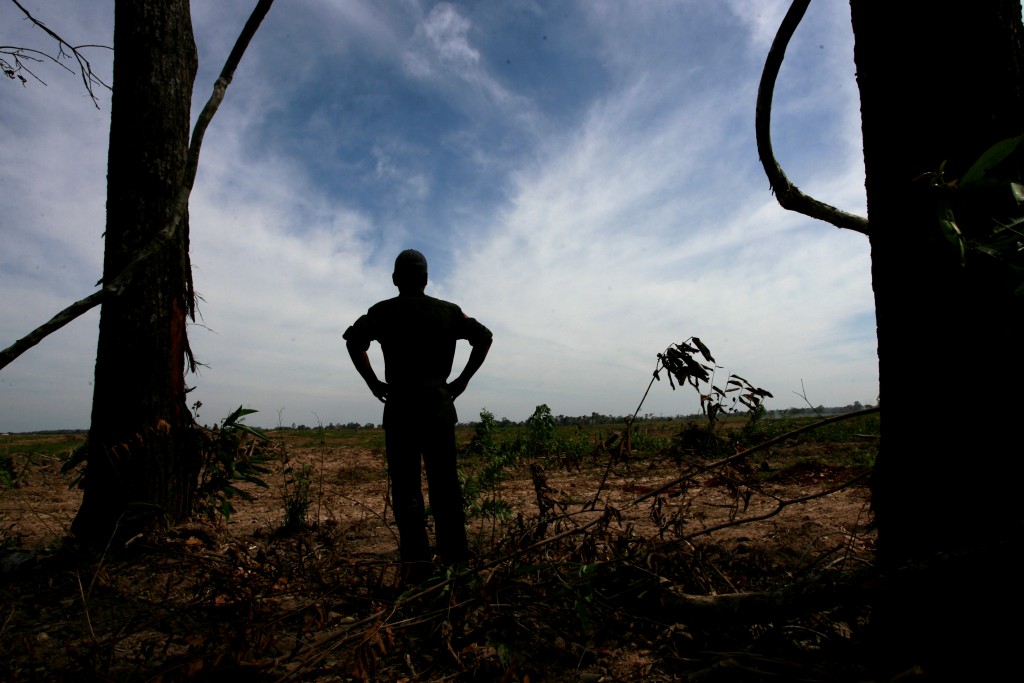
សឿន រ៉ន សមាជិកសហគមន៍ផលិតជ័រ សម្លឹងទៅដីឈូសឆាយមួយកន្លែង ដែលដើមឈើផ្តល់ជ័ររបស់គាត់ស្ថិតនៅ។ តំបន់នេះ គឺជាផ្នែកមួយនៃព្រៃខៀវ សហគមន៍ព្រៃឈើ នៅអូរព្រះ ឃុំអូរឃ្លាំង ខេត្តក្រចេះ។ រូបភាព ថតដោយ អង្គការអុកស្វាម ចក្រភពអង់គ្លេស ប្រចាំតំបន់អាស៊ី។ ក្រោមអាជ្ញាប័ណ្ណ Creative Commons Attribution-NonCommercial-NoDerivs 2.0.
នៅកម្ពុជា សិទ្ធិដីសមូហភាព មានច្រើនទម្រង់ ហើយប្រភេទដែលត្រូវបានគេស្គាល់ច្បាស់ គឺសិទ្ធិរបស់សហគមន៍ជនជាតិដើម។ ជាមួយនឹងអត្តសញ្ញាណខាងវប្បធម៌ សហគមន៍ជនជាតិដើមនៅប្រទេសកម្ពុជា មានចំណងរឹងមាំខាងវប្បធម៌ សាសនា និងសេដ្ឋកិច្ច ផ្សាភ្ជាប់ទៅនឹងដី។ បើទោះជារដ្ឋាភិបាលកម្ពុជា ទទួលស្គាល់សិទ្ធិដីសមូហភាព ដំណើរការក្នុងការការពារសិទ្ធិទាំងនោះសម្រាប់សហគមន៍ជនជាតិដើម នៅយឺតយ៉ាវ។1 សហគមន៍មួយចំនួនបានធ្វើការអស់រយៈពេល ៤ ទៅ ៨ ឆ្នាំ ជាមួយការជួយគាំទ្រគួរឱ្យកត់សម្គាល់ពីសំណាក់អង្គការមិនមែនរដ្ឋាភិបាលនានា នៅមុនពេលទទួលបានការវាស់វែងដី។ អង្គការមិនមែនរដ្ឋាភិបាល បានអះអាងថា វឌ្ឍនភាពយឺតយ៉ាវលើកិច្ចការទាំងនេះ អាចបណ្តាលឱ្យប៉ះពាល់ដល់សិទ្ធិដីធ្លី និងធនធានធម្មជាតិ។2
យោងច្បាប់ភូមិបាលឆ្នាំ ២០០១ កម្មសិទ្ធិសមូហភាព ឬសហគមន៍ មានពីរប្រភេទ ៖ កម្មសិទ្ធិរបស់វត្តអារាម និង កម្មសិទ្ធិរបស់សហគមន៍ជនជាតិដើម។ កម្មសិទ្ធិរបស់វត្តអារាម រួមមានដី និងសំណង់ដែលមាននៅក្នុង និងក្រៅបរិវេណវត្តអារាមព្រះពុទ្ធសាសនា ដែលជារបស់សាសនាព្រះពុទ្ធ។3 កម្មសិទ្ធិនេះ មិនអាចទៅលក់ដូរ ដោះដូរ ឬធ្វើអំណោយ និងទាំងមិនអាចកាន់កាប់ស្របច្បាប់ដោយបុគ្គលណាផ្សេងឡើយ។ យ៉ាងនេះក្តី ដីនោះអាចត្រូវបានជួល ឬដាំដំណាំរួម ដរាបណាប្រាក់ចំណូលទទួលបានត្រូវបានប្រើប្រាស់សម្រាប់កិច្ចការក្នុងសាសនាប៉ុណ្ណោះ។4
កម្មសិទ្ធិសហគមន៍ជនជាតិដើម
កម្មសិទ្ធិសហគមន៍ជនជាតិដើម គឺជាដីដែលប្រើប្រាស់ដោយសហគមន៍ជនជាតិដើម ហើយសហគមន៍ជនជាតិ អាចស្នើសុំប័ណ្ណកម្មសិទ្ធិជាសមូហភាពលើដីនោះបាន។ (ដីសមូហភាព គឺជាប្រភេទដីដែលកើតឡើងពីដីដាច់ដោយឡែកច្រើន ដែលដីនីមួយៗទទួលបានកម្មសិទ្ធិដោយឡែកៗ)។ ដីដែលបានចុះជាដីសមូហភាព មិនត្រូវបានអនុញ្ញាតឱ្យលក់ដូរ ឬបញ្ចាំនោះទេ។ នេះគឺជាការវិធីដើម្បីការពារព្រៃអារក្ស ដីកប់ខ្មោច និងដីដូនតាសំខាន់ៗសម្រាប់ពេលកូនចៅជំនាន់ក្រោយ។
ច្បាប់ភូមិបាល ផ្តល់និយមន័យសហគមន៍ជនជាតិដើម ថាជាក្រុមបុគ្គលដែលបង្ហាញនូវឯកភាពនៃជាតិពន្ធុ សង្គមវប្បធម៌ និងសេដ្ឋកិច្ច ប្រតិបត្តិរបៀបរស់នៅតាមប្រពៃណី និងដាំដុះលើដីដែលខ្លួនកាន់កាប់ទៅតាមក្បួនខ្នាតទំនៀមទំលាប់នៃការប្រើប្រាស់ជាសមូហភាព។5 ប្រទេសកម្ពុជាមានជនជាតិដើមភាគតិចចំនួន ២៤ ក្រុម ដែលពួកគេទាំងនោះត្រូវបានប៉ាន់ប្រមាណថាមាន ៤៥០ ទៅ ៥០០ សហគមន៍។ 6 ជាទូទៅ ជនជាតិដើមភាគតិចត្រូវបានទទួលស្គាល់ថា មានចំនួន ១ ទៅ ២ ភាគរយនៃប្រជាជនសរុបនៅកម្ពុជា ប៉ុន្តែចំនួនរបស់ពួកគេនៅមិនទាន់មានការប៉ាន់ប្រមាណច្បាស់លាស់ណាមួយនៅឡើយទេនៅក្នុងជំរឿនជាតិ។7
សហគមន៍ជនជាតិដើមភាគតិច ភាគច្រើនមិនមានចេះនិយាយ ឬអានភាសាខ្មែរបានទេ។ អ្នកសិក្សាស្រាវជ្រាវ បានអះអាងថា ចំណុចនេះ បូករួមនឹងកង្វះការចូលរួមជាប្រពៃណីក្នុងមជ្ឈដ្ឋាននយោបាយជាតិ បានរាំងស្ទះលទ្ធភាពរបស់ពួកគេក្នុងការទទួលបានប័ណ្ណកម្មសិទ្ធិជាសមូហភាព។8
ការទទួលបានកម្មសិទ្ធិសមូហភាព
ខណៈដែលច្បាប់ភូមិបាលឆ្នាំ ២០០១ បានណែនាំពីការកម្មសិទ្ធិដីសមូហភាព ដំណើរការនៃការផ្តល់កម្មសិទ្ធិនេះមិនមានភាពច្បាស់លាស់ទេ។ រហូតដល់ឆ្នាំ ២០០៩ ភាពច្បាស់លាស់បានមកដល់ជាមួយនឹងអនុក្រឹត្យលេខ ៨៣ ស្តីពីនីតិវិធីនៃការចុះបញ្ជីដីសហគមន៍ជនជាតិដើមភាគតិច9 និងសារាចរណ៍របស់ក្រសួងអភិវឌ្ឍន៍ជនបទស្តីពីនីតិវិធី និងវិធាននៃការអនុវត្តគោលការណ៍ជាតិស្តិពីការអភិវឌ្ឍ និងការកំណត់អត្តសញ្ញាណនៃសហគមន៍ជនជាតិដើមភាគតិច។
អនុក្រឹត្យលេខ ៨៣ ស្តីពីការចុះបញ្ជីដីសហគមន៍ជនជាតិដើមភាគតិច បានផ្តល់ក្របខ័ណ្ឌច្បាប់ ដែលសហគមន៍ជនជាតិដើមភាគតិចអាចទទួលបានប័ណ្ណកម្មសិទ្ធជាសមូហភាពលើដីសហគមន៍ តាមរយៈ ៣ ដំណាក់កាល៖
- លិខិតទទួលស្គាល់ថាជាសហគមន៍ជនជាតិដើមភាគតិចចេញដោយក្រសួងអភិវឌ្ឍន៍ជនបទ (នៅក្នុងខែ កុម្ភៈ ឆ្នាំ ២០១៧, សហគមន៍ចំនួន ១១៩ បានទទួលលិខិតនេះ)10
- ការចុះបញ្ជីសហគមន៍ជានីតិបុគ្គលស្របច្បាប់ ដែលបានចុះបញ្ជីដោយក្រសួងមហាផ្ទៃ។ (សហគមន៍ចំនួន ១០២ ត្រូវបានចុះបញ្ជី)
- ចុះវាស់វែងដី និងចេញប័ណ្ណកម្មសិទ្ធិនៃការប្រើប្រាស់ដីដោយក្រសួងគ្រប់គ្រងដែនដី នគរូបនីយកម្ម និងសំណង់។ (សហគមន៍ចំនួន ៥៤ បានដាក់ពាក្យស្នើសុំនៅដំណាក់កាលនេះ ហើយសហគមន៍ ១៤ បានទទួលប័ណ្ណកម្មសិទ្ធិ)។
ដំណើរការនេះតម្រូវថា សហគមន៍មានដីកា និងបទបញ្ជាផ្ទៃក្នុងដែលគ្រប់គ្រងលើការប្រើប្រាស់ និងការគ្រប់គ្រងដី។11
អនុក្រឹត្យនេះ ដាក់ចេញនូវលក្ខខណ្ឌមួយចំនួនដើម្បីទទួលបានការចុះបញ្ជីកម្មសិទ្ធដីសមូហភាព៖
- ដីឯកជនរបស់រដ្ឋ៖
- ដីលំនៅឋាន ឬដីដែលសហគមន៍បានរៀបចំនិវេសនដ្ឋាន
- ដីសហគមន៍ប្រកបរបរកសិកម្មប្រពៃណី មានដីដែលដាំដុះជាក់ស្តែង ដីស្រែចម្ការ និង
- ដីសាធារណៈរបស់រដ្ឋ ដែលបានចុះបញ្ជីរួចហើយជាមួយរដ្ឋ ដូចជា៖
- ដីបម្រុងចាំបាច់ក្នុងការដូរវេនដំណាំ ដែលទទួលស្គាល់ដោយអាជ្ញាធររដ្ឋាល និងការព្រមព្រៀងពីអ្នកជិតខាង
- ដីព្រៃអារក្ស ដែលអាចមានមួយកន្លែង ឬច្រើនកន្លែងសម្រាប់សហគមន៍នីមួយៗ ដោយមានទំហំសរុបមិលើសពី ប្រាំពីរ ហិកតា
- ដីកប់ខ្មោច ដែលមានមួយកន្លែង ឬច្រើនកន្លែងសម្រាប់សហគមន៍នីមួយៗ ដោយមានទំហំសរុបមិនលើសពី ប្រាំពីរ ហិកតា។
ប្រសិនដីសមូហភាព ស្ថិតក្នុងដីសាធារណៈរបស់រដ្ឋ អនុក្រឹត្យនេះ ទាមទារអោយមានការកែប្រែចំនែកដីនោះទៅជាដីឯកជនរបស់រដ្ឋ ដើម្បីទទួលបានកម្មសិទ្ធតាមរយៈការធ្វើប្រទានកម្ម។
មានតែតំបន់តូចៗនៃព្រៃប៉ុណ្ណោះ អាចរាប់បញ្ជូលទៅក្នុងការចុះបញ្ជីកម្មសិទ្ធដីសមូហភាព ដោយមិនលើសពី ១៤ ហិកតា ក្នុងមួយភូមិនោះទេ។
ឯកសារ ៖ សហគមន៍ ល្អាង ក្នុងខេត្តរតនគីរី និងសហគមន៍ស្រែខ្ទុម ក្នុងខេត្តមណ្ឌលគីរី សហគមន៍ល្អាង ជាផ្ទះសម្បែងរបស់ជនជាតិទំពូន ១០១គ្រួសារ នៅខេត្តរតនគីរី គឺជាសហគមន៍ទីមួយដែលទទួលប័ណ្ណកម្មសិទ្ធិជាសមូហភាពគឺសហគមន៍។ ប័ណ្ណកម្មសិទ្ធិរបស់ពួកគេគ្របដណ្តប់លើផ្ទៃដីទំហំ១,៤៥៤ ហិចតា ហើយដំណើរការចេញប័ណ្ណកម្មសិទ្ធិ ដោយមានកិច្ចសហការពីអង្គការភាពជាដៃគូរអភវិឌ្ឍន៍ក្នុងសកម្មភាព ចំណាយពេលអស់ ៥ ឆ្នាំ ។ បើតាមអ្នកសិក្សាស្រាវជ្រាវ ជោគជ័យរបស់សហគមន៍ល្អាង ក្នុងការទទួលបានប័ណ្ណកម្មសិទ្ធិសមូហភាព គឺដោយសារតែវានៅឆ្ងាយពីដីសម្បទានសេដ្ឋកិច្ច និងតំបន់ការពារ។12 នៅខែ មិថុនា ឆ្នាំ ២០១៣13 ប័ណ្ណកម្មសិទ្ធិសមូហភាពរបស់សហគមន៍ជនជាតិព្នងក្នុងភូមិស្រែខ្ទុម ខេត្តមណ្ឌលគីរី ត្រូវបានផ្តល់ទៅឱ្យមនុស្ស ១០២គ្រួសារ លើផ្ទៃដី ១,០៨៤ ហិចតា។ សហគមន៍នេះ ត្រួតគ្នានឹងដីសម្បទានជាច្រើនកន្លែង និងតំបន់ការពារមួយកន្លែង ហើយបានប្រឈមនឹងសម្ពាធខាងក្រៅជាច្រើន។ បន្ទាប់ពីការមកដល់នៃអ្នកវាស់វែងដីធ្លីតាមបទបញ្ជាលេខ ០១ ប្រជាជន ១២ គ្រួសារ ដែលភាគច្រើនជាជនជាតិខ្មែរភាគតិច យល់ព្រមទទួលបានប័ណ្ណកម្មសិទ្ធិឯកជន។ ភូមិនេះ បានទទួលព័ត៌មានស្តីពីប័ណ្ណកម្មសិទ្ធិសមូហភាព និងការគាំទ្រពីអង្គការមិនមែនរដ្ឋាភិបាលមួយ។14 |
បញ្ហាប្រឈមនៃការការពារសិទ្ធិសហគមន៍ជនជាតិដើមភាគតិច
រដ្ឋាភិបាលបាន បានប្តេជ្ញាការពារសិទ្ធិ និងវប្បធម៌របស់ជនជាតិដើមភាគតិច។15 ទោះជាយ៉ាងដូច្នេះ អ្នកសិក្សាស្រាវជ្រាវ និង អង្គការមិនមែនរដ្ឋាភិបាល បានលើកឡើងពីកង្វង់ជាច្រើនអំពីការការពារសិទ្ធិដីធ្លីរបស់សហគមន៍ជនជាតិដើមភាគតិច ។ សិទ្ធិកម្មសិទ្ធិសមូហភាព ត្រូវបានទទួលស្គាល់នៅពេលដែលច្បាប់ភូមិបាលត្រូវបានអនុម័តកាលពីឆ្នាំ ២០០១ ប៉ុន្តែក្របខ័ណ្ឌសម្រាប់ការទទួលបានប័ណ្ណកម្មសិទ្ធិសមូហភាពមិនទាន់មានឡើយ រហូតដល់ឆ្នាំ ២០០៩។ យោងតាមទិន្នន័យរបស់រដ្ឋាភិបាល នៅត្រឹមឆ្នាំ២០០៩ យ៉ាងហោចណាស់ ផ្ទៃដីចំនួន ១.២ លានហិចតា16 ត្រូវបានផ្តល់ជាសម្បទានដីសេដ្ឋកិច្ច។ អង្គការមិនមែនរដ្ឋាភិបាល បានរាយការណ៍ថា ផ្ទៃដីចំនួន ២ លានហិចតា ត្រូវបានផ្តល់ជាសម្បទានដីសេដ្ឋកិច្ច។17
ប័ណ្ណកម្មសិទ្ធិជាសមូហភាពដំបូងត្រូវបានផ្តល់ឲ្យនៅឆ្នាំ ២០១១។18 អង្គការមិនមែនរដ្ឋាភិបាលផ្សេងៗបានបង្ហាញក្តីកង្វល់ថា វឌ្ឍនភាពយឺតអាចបណ្តាលមកពីភាពស្មុគស្មាញនៃដំណើរការ និងឥទ្ធិពលអំណាចរបស់វិនិយោគិន និងសហគមន៍ជនជាតិដើមភាគតិច ហើយដែលសហគមន៍ជនជាតិដើម តែងតែរស់នៅក្នុងតំបន់ដែលសំបូរធនធានធម្មជាតិ។19 ក្រៅពីនេះ ក្នុងអំឡុងដំណើរការស្នើសុំដ៏យូរ សហគមន៍ជនជាតិដើមភាគតិចមិនទទួលបានការការពារពីហានិភ័យដែលកើតឡើងពីការផ្តល់សម្បទានដីសេដ្ឋកិច្ចលើដីធ្លីរបស់ពួកគេ រហូតទាល់តែពួកគេបានបំពេញជំហានដំបូងពីរនៃដំណើរការស្នើសុំសិន។20 អ្នកសិក្សាស្រាវជ្រាវ រាយការណ៍ឱ្យដឹងថា សហគមន៍ដែលត្រួតគ្នា ឬមានទីតាំងនៅជិតសម្បទាន ប្រឈមនឹងការលំបាកជាខ្លាំងក្នុងការទទួលបានប័ណ្ណកម្មសិទ្ធិ។21
ក្នុងអំឡុងពេលអនុវត្តបទបញ្ជាលេខ ០១ សេចក្តីបារម្ភជាច្រើនក៏កើតមានឡើង ថាវាបានធ្វើឱ្យប៉ះពាល់ដំណើរការនៃការផ្តល់កម្មសិទ្ធិសមូហភាព។ កម្មវិធីនេះ បានផ្តល់អាទិភាពចម្បងលើការចុះបញ្ជីដី កម្មសិទ្ធិបុគ្គល លើសិទ្ធិកម្មសិទ្ធិសមូហភាព។ មន្ត្រីរដ្ឋាភិបាល បានអះអាងថា ការចេញប័ណ្ណកម្មសិទ្ធិសម្រាប់សហគមន៍ មានភាពសាំញ៉ាំ និងជាដំណើរការប្រើពេលវេលាដែលត្រូវចំណាយធនធានច្រើនសម្រាប់កិច្ចខិតខំចេញប័ណ្ណកម្មសិទ្ធិនេះ នៅទូទាំងប្រទេស។ យ៉ាងនេះក្តី គ្រួសារនៅក្នុងតំបន់ជនជាតិដើម ត្រូវបានផ្តល់ជាកម្មសិទ្ធិឯកជន ជំនួសឱ្យប័ណ្ណកម្មសិទ្ធិសមូហភាពវិញ។22
បច្ចុប្បន្ននេះ នៅពេលដែលសមាជិកសហគមន៍បានទទួលកម្មសិទ្ធិជាបុគ្គលរួចហើយ ពួកគេមិនអាចទទួលកម្មសិទ្ធិលើដីសមូហភាពទេ បើទោះបីជារដ្ឋាភិបាលមានផែនការនឹងបង្កើតដំណើរការមួយ ដើម្បីបញ្ចូលកម្មសិទ្ធិជាបុគ្គលនេះ ទៅក្នុងកម្មសិទ្ធិសមូហភាពក៏ដោយ។ ការផ្តល់ប័ណ្ណកម្មសិទ្ធិឯកជន ទៅឱ្យសហគមន៍ជនជាតិដើម បានក្លាយជាបញ្ហាចម្រូងចម្រាសមួយ។ អង្គការមិនមែនរដ្ឋាភិបាល បានរាយការណ៍ថា ការអនុវត្តនេះ អាចនាំឱ្យមានការបែងចែកខាងសង្គម ពីព្រោះថា នៅពេលដែលសមាជិកសហគមន៍ជនជាតិ ចុះបញ្ជីដីជាកម្មសិទ្ធិឯកជន នោះជាដំបូង ពួកគេត្រូវចាកចេញពីសហគមន៍ របស់ពួកគេ។23 បន្ទាប់ពីចាកចេញ ពួកគេក៏លែងមានសិទ្ធិទទួលដីជនជាតិដើមជាសមូហភាពដែរ។
របាយការណ៍សិក្សាស្រាវជ្រាវជាច្រើន បានបង្ហាញថា មានការដាក់សម្ពាធគ្រួសារមួយចំនួនឱ្យចាក ចេញពីសហគមន៍របស់ពួកគេ និងទទួលយកកម្មសិទ្ធិជាលក្ខណៈបុគ្គលវិញ។24 អ្នកសិក្សាស្រាវជ្រាវ មកពី អង្គការហ៊ែនរិច បូល ប្រចាំប្រទេសកម្ពុជា បានឱ្យដឹងថា ការអនុវត្តខុស និងការដាក់សម្ពាធ អ្នកភូមិ ឱ្យទទួលយកកម្មសិទ្ធិឯកជន ហើយធ្វើឱ្យបាត់បង់សិទ្ធិទាមទារលើដីសមូហភាព មានការរីករាលដាល នៅក្រោមកម្មវិធីបទបញ្ជាលេខ ០១។25 អ្នកសិក្សាទាំងនោះ អះអាងថា រដ្ឋាភិបាលប្រើប្រាស់កម្មវិធីចេញ ប័ណ្ណកម្មសិទ្ធិទាំងនោះ ដើម្បីបំបែកបំបាក់សហគមន៍នៅក្នុងតំបន់សម្បូរធនធាន ដែលមានជនជាតិដើម ភាគតិចរស់នៅ។
ក្រៅពីនេះ ក៏មានសេចក្តីរាយការណ៍ដែរថា នៅក្នុងការអនុវត្តបទបញ្ជាលេខ០១ ដីមិនបង្ករបង្កើន ផល និងដីព្រៃរបស់គ្រួសារជនជាតិដើម ជាញយៗ មិនត្រូវបានពិនិត្យសិក្សាដោយក្រុមការងារសុរិយោដី ទេ។26 ដោយសារបញ្ហានេះ បុគ្គលដែលបានទទួលយកកម្មសិទ្ធិឯកជន អាចបាត់បង់លទ្ធភាពប្រើប្រាស់ដី ព្រៃជំនឿសមូហភាព ដីបញ្ចុះសព ឬដីមិនបង្ករបង្កើនផល សម្រាប់ការធ្វើកសិកម្មជាលក្ខណៈប្រពៃណី។ ជាវិបាក របាយការណ៍មួយចំនួន បង្ហាញថា បន្ទាប់ពីការសិក្សានៅតំបន់ជម្លោះបានបញ្ចប់ ក្រុមហ៊ុនឯកជនខ្លះកំពុងព្យាយាមទាក់ទងដីមិនទាន់ចុះបញ្ជី ដែលមានសារៈសំខាន់សម្រាប់សហគមន៍ជនជាតិដើម។27
ការសិក្សាថ្មីបំផុត ទៅលើបទបញ្ជាលេខ ០១ មិនបានរកឃើញភស្តុតាងពីការបង្ខិតបង្ខំរាលដាល ទៅលើសហគមន៍ ឱ្យទទួលយកកម្មសិទ្ធិនោះទេ។28 របាយការណ៍ បង្ហាញថា នៅក្នុងករណីខ្លះ គ្រួសារជនជាតិដើម បានទទួលយកកម្មសិទ្ធិឯកជន សម្រាប់ហេតុផលជាក់ស្តែង រាប់បញ្ចូលទាំងដើម្បីការពារកម្មសិទ្ធិរបស់ពួកគេ ពីការគម្រាមកំហែង ឬទទួលបានប្រាក់កម្ចី។ ការសិក្សា ក៏រកឃើញផងដែរថា ក្នុងករណីមួយចំនួនទៀត សមាជិកសហគមន៍ ត្រូវបានលើកទឹកចិត្តឱ្យទទួលយកកម្មសិទ្ធិជាបុគ្គល និងករណីដោយឡែកទៀត ក្រុមគ្រួសារជនជាតិ មិនបានទទួលប័ណ្ណកម្មសិទ្ធិសម្រាប់ក្បាលដីរបស់ ពួកគាត់ ដែលធ្វើឱ្យពួកគេងាយរងគ្រោះនឹងការដណ្តើមយកដីពីអ្នកខាងក្រៅ។29
រដ្ឋាភិបាល បានទទួលស្គាល់ការរិះគន់លើបញ្ហាចេញប័ណ្ណកម្មសិទ្ធិ នៅក្នុងតំបន់ជនជាតិដើមរស់ នៅ។ ខណៈដែលបដិសេធការអះអាងរបស់ក្រុមការងារសិក្សាស្រាវជ្រាវ ថាការមានប្រើសម្ពាធបង្ខំឱ្យ សហគមន៍ទទួលយកប័ណ្ណកម្មសិទ្ធិឯកជន30 មន្ត្រីរដ្ឋាភិបាល បានបង្កើតជាការប្តេជ្ញាខាងគោលនយោបាយ សំដៅធ្វើឱ្យកាន់តែប្រសើរលើសូចនាករ ទាក់ទងនឹងការចេញប័ណ្ណកម្មសិទ្ធិលើដីសមូហភាពរបស់ជនជាតិដើម។31 ក្នុងអំឡុងឆ្នាំ២០១៤-២០១៥ រដ្ឋាភិបាល មានផែនការធានាថា៖
- យ៉ាងហោចណាស់ សហគមន៍ជនជាតិដើមចំនួន ១០ នឹងទទួលបានកម្មសិទ្ធិសមូហភាព នៅរៀងរាល់ឆ្នាំ។ មូលនិធិរដ្ឋាភិបាលអាចផ្តល់អោយបាននៅជំហានទីបី នៃដំណើរការនេះ ដែលអាចផ្តល់អោយរហូតដល់ ១០ សហគមន៍ ហើយក្នុងមួយសហគមន៍ទទួលបាន ថវិកាចំនួន ៣០, ០០០ ដុល្លារ
- វិធានការ ការពារជាបណ្តោះអាសន្ន នឹងត្រូវដាក់ចុះដើម្បីការពារសហគមន៍ ដែលបានដាក់ពាក្យសុំកម្មសិទ្ធិសមូហភាព។ ទី៣ សេចក្តីណែនាំច្បាស់លាស់ នឹងដាក់ចេញមក សំដៅបំលែងកម្មសិទ្ធិដីឯកជនរបស់បងប្អូនជនជាតិដើម ទៅជាកម្មសិទ្ធិដីសមូហភាព។32
- ចំណុចចុងក្រោយនេះ គឺជាផ្នែកមួយដ៏សំខាន់សម្រាប់ជាពន្លឺដល់បទបញ្ជាលេខ០១ ពីព្រោះវាមានន័យថា ជនទាំងឡាយណា ដែលទទួលយករបបកម្មសិទ្ធិសមូហភាព នឹងទទួលបានសិទ្ធិជាថ្មីម្តងទៀតលើប័ណ្ណកម្មសិទ្ធិសមូហភាព និង ការប្រើប្រាស់ដីសមូហភាព។
ទម្រង់ផ្សេងទៀតនៃកម្មសិទ្ធិសមូហភាព រួមមាន ព្រៃសហគមន៍ និងតំបន់ការពារសហគមន៍។ សូមអានទំព័របន្តបន្ទាប់ដើម្បីទទួលបានព័ត៌មានបន្ថែមស្តីពីព្រៃសហគមន៍ និងតំបន់ការពារសហគមន៍។
ទាក់ទងនឹងដីសមូហភាព
បច្ចុប្បន្នភាពចុងក្រោយ នៅថ្ងៃទី ២៦ ខែកុម្ភៈ ឆ្នាំ២០១៧
ឯកសារយោង
- 1. លុច មូនីកា. ឆ្នាំ២០១៣. “ការវាយតម្លៃសិទ្ធិមនុស្សរបស់កម្មវិធីសិទ្ធិដីធ្លីអាល្លឺម៉ង់-កម្ពុជា” មជ្ឈមណ្ឌលសិទ្ធិមនុស្សអាល្លឺម៉ង់ https://landportal.org/library/resources/mlrf2186/human-rights-assessment-german-cambodian-land-rights-program-lrp ។
- 2. មជ្ឈមណ្ឌលសិទ្ធិមនុស្សកម្ពុជា. ២០១៣. “កម្ពុជា ៖ ជម្លោះដីធ្លី-ខ្លឹមសារសង្ខេបនៃស្ថានភាពដីធ្លី” http://bit.ly/1KtPNVy ។
- 3. ច្បាប់ភូមិបាលឆ្នាំ ២០០១ មាត្រា ២០។
- 4. ច្បាប់ភូមិបាលឆ្នាំ ២០០១ មាត្រា ២១។
- 5. ច្បាប់ភូមិបាល ឆ្នាំ ២០០១ មាត្រា ២៣។
- 6. Cristina Maza,”ការស្រាវជ្រាវ៖ ក្រុមជនជាតិដើមភាគតិចនៅកម្ពុជា មានចំនួនច្រើនជាងចំនួនកត់ត្រាបច្ចុប្បន្ន”, កាសែតភ្នំពេញប៉ុស្តិ៍, ចុះថ្ងៃទី ២៧ ខែ តុលា ឆ្នាំ ២០១៦។ http://bit.ly/2e3eKwn
- 7. វេទិកានៃអង្គការមិនមែនរដ្ឋាភិបាល ស្តីពីកម្ពុជា, ២០១៦. “គម្រោងស្តីពីសិទ្ធិជនជាតិដើមភាគតិច.” ចូលអានថ្ងៃទី ២៦ ខែមិថុនា ឆ្នាំ ២០១៦។ http://www.ngoforum.org.kh/index.php/en/indigenous-peoples-land-rights-project
- 8. វីស ជែហ្វ និង មែនហ្វ្រែដ ហោណាង (២០១៣). “ជនជាតិដើមភាគតិច និងការផ្តល់ប័ណ្ណកម្មសិទ្ធិដីធ្លីនៅកម្ពុជា ៖ ការសិក្សាពីភូមិចំនួន ៦” មូលនិធិបូលហ្វោនដេសិន ។ បទបង្ហាញក្នុងសន្និសីទប្រចាំឆ្នាំរបស់ធនាគារពិភពលោកស្តីពីដីធ្លី និងភាពក្រីក្រ នៅរដ្ឋធានីវ៉ាស៊ីតោន ថ្ងៃទី ៨-១១ ខែ មេសា។ http://www.boell.de/sites/default/files/indigenous-peoples-and-land-titling-in-cambodia_a-study-of-six-villages.pdf
- 9. អនុក្រឹត្យលេខ ៨៣ ស្តីពីការចុះបញ្ជីដីសហគមន៍ជនជាតិដើម។ http://bit.ly/2nlLsLm
- 10. IMG Consultancy 2017, កិច្ចសម្ភាសន៍ ថ្ងៃទី ២២ ខែ មករា ឆ្នាំ ២០១៧, ភ្នំពេញ។
- 11. អនុក្រឹត្យលេខ ៨៣, មាត្រា ៨។
- 12. វីស (ឆ្នាំ២០១៣)។
- 13. គុជ ណារ៉ែន (២០១៣). “សហគមន៍ចំនួន ៨ នៅខេត្តមណ្ឌលគីរី ទទួលបានប័ណ្ណកម្មសិទ្ធិធ្លី” ថ្ងៃទី ១១ ខែ មិថុនា។ http://sahrika.com/2013/06/11/eighth-communal-land-title-awarded-in-mondolkiri/
- 14. វីស (ឆ្នាំ២០១៣)។
- 15. ផែនការយុទ្ធសាស្រ្តអភិវឌ្ឍន៍ជាតិ ឆ្នាំ ២០១៤-២០១៨. http://www.maff.gov.kh/គោលនយោបាយ/1240-nsdp-2014-2018-en.html
- 16. ក្រសួងកសិកម្ម រុក្ខាប្រមាញ់ និងនេសាទ. “ដីសម្បទានសេដ្ឋកិច្ច: ទិដ្ឋភាពទូទៅ.” ចូលអាននៅថ្ងៃទី ៧ ខែ កក្កដា ឆ្នាំ ២០១៥។http://www.maff.gov.kh/elc/
- 17. សូរិយា ស៊ូប៊ែរឌី. ឆ្នាំ២០១២. “របាយការណ៍របស់អ្នករាយការណ៍ពិសេសស្តីពីស្ថានភាពសិទ្ធិមនុស្សនៅកម្ពុជា។ សូរិយា ស៊ូប៊ែរឌី. ទំព័របន្ថែម: ការវិភាគសិទ្ធិមនុស្សlលើបញ្ហាសម្បទានដីសេដ្ឋកិច្ច និងសម្បទានដីផ្សេងទៀត នៅកម្ពុជា.” ក្រុមប្រឹក្សាសិទ្ធិមនុស្ស. កិច្ចប្រជុំលើកទី២១ ថ្ងៃទី ១១ ខែ តុលា ឆ្នាំ ២០០៩. http://cambodia.ohchr.org/WebDOCs/DocReports/3-SG-RA-Reports/A-HRC-21-63_en.pdf ។
- 18. ការិយាល័យឧត្តមស្នងការអង្គការសហប្រជាជាតិទទួលបន្ទុកសិទ្ធិមនុស្ស (២០១១). “សេចក្តីប្រកាសព័ត៌មាន៖ សហគមន៍ជនជាតិដើមភាគតិចចំនួន ៣ នឹងទទួលបានប័ណ្ណកម្មសិទ្ធិដីសមូហភាព.” អង្គការសហប្រជាជាតិ. ថ្ងៃទី ១៤ ខែ ធ្នូ. http://cambodia.ohchr.org/WebDOCs/DocNewsIndex/2011/122011/3_indigenous_communities_to_receive_communal_land_titles_Eng.pdf ។
- 19. លុក. ឆ្នាំ២០១៣។
- 20. មជ្ឈមណ្ឌលសិទ្ធិមនុស្សកម្ពុជា. ឆ្នាំ២០១៣។
- 21. វីស. ឆ្នាំ២០១៣។
- 22. ហ្រ្គីមឌីជ. ឆ្នាំ២០១៥។
- 23. វីស. ឆ្នាំ២០១៣។ អនុក្រឹត្យ លេខ ៨៣ ស្តីពីនីតិវិធីនៃការចុះបញ្ជីដីសហគមន៍ជនជាតិដើមភាគតិច, មាត្រា១៤។
- 24. អង្គការឃ្លាំមើលសិទ្ធិមនុស្ស. ឆ្នាំ២០១៣. “យុទ្ធនាការផ្តល់ប័ណ្ណកម្មសិទ្ធិនៅកម្ពុជា បើកផ្លូវឱ្យមានការរំលោភសិទ្ធិ.” ចូលអាននៅថ្ងៃទី ១២ ខែមិថុនា ឆ្នាំ២០១៣. https://www.hrw.org/news/2013/06/12/cambodia-land-titling-campaign-open-abuse ។
- 25. វីស. ឆ្នាំ២០១៣ ។
- 26. ហ្វ្រេង វ៉ុលគ មូល័រ និង ហ្គាឌរ ហ្ស៊ុលដូហ្វ. ឆ្នាំ២០១៣. “គោលនយោបាយចាស់-ចំណាត់ការថ្មី ៖ គំនិតផ្តួចផ្តើមនយោបាយដ៏គួរឲ្យភ្ញាក់ផ្អើលក្នុងការទទួលស្គាល់សិទ្ធិមនុស្សក្នុងកំណែទម្រង់ដីធ្លីនៅកម្ពុជា” បទបង្ហាញក្នុងសន្និសីទប្រចាំឆ្នាំរបស់ធនាគារពិភពលោកស្តីពីដីធ្លី និងភាពក្រីក្រ, រដ្ឋធានី Washington, D.C., ថ្ងៃទី ៨-១១ ខែ មេសា។ http://www.oicrf.org/document.asp?ID=11816
- 27. ហ្វ្រេង វ៉ុលគ មូល័រ និង ហ្គាឌរ ហ្ស៊ុលដូហ្វ. ឆ្នាំ២០១៣។
- 28. ហ្រ្គីមឌីជ. ឆ្នាំ២០១៥. ទំព័រ៣៦។
- 29. ហ្រ្គីមឌីជ (ឆ្នាំ២០១៥)។
- 30. ចាន់ សុផល. ឆ្នាំ២០១២. “សេចក្តីបញ្ជាក់ការអនុវត្តសកម្មភាពថ្មីលើគោលនយោបាយចាស់ សម្រាប់វិស័យដីធ្លី សម្រាប់តាមបទបញ្ញា លេខ ០១ របស់រាជរដ្ឋាភិបាល ដោយឆ្លើយតបទៅនឹងលិខិតរបស់លោក សូរិយា ស៊ូប៊ែរឌី.” ក្រសួងដែនដី នគររូបនីយកម្ម និងសំណង់. លេខ១១៧៧ ថ្ងៃទី ២០ ខែកញ្ញា. http://www.mlmupc.gov.kh/mlm/imgs/ Show-BB01-Surya%20P-Subedi-en.pdf
- 31. រាជរដ្ឋាភិបាល នៃព្រះរាជាណាចក្រកម្ពុជា. ឆ្នាំ២០១៤. “សូចនាករតាមដានរួមសម្រាប់ឆ្នាំ២០១៤-២០១៨.” ចូលអាននៅថ្ងៃទី ២៣ ខែតុលា ឆ្នាំ២០១៥. http://www.cdc-crdb.gov.kh/cdc/documents/jmi/JMI_2014_2018_EN.pdf. ។
- 32. រាជរដ្ឋាភិបាល នៃព្រះរាជាណាចក្រកម្ពុជា. ឆ្នាំ២០១៤។

